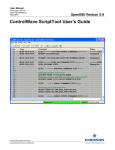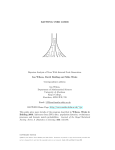Download Elixir Repertoire User Manual - Elixir Ambience and Repertoire
Transcript
Elixir Repertoire User Manual
Release 3.0.0
Elixir Technology Pte Ltd
Elixir Repertoire User Manual: Release 3.0.0
Elixir Technology Pte Ltd
Published 2014
Copyright © 2014 Elixir Technology Pte Ltd
All rights reserved.
Java is a trademark or registered trademark of Oracle Corporation in the United States and other countries. Microsoft and Windows are trademarks
of Microsoft Corporation.
Table of Contents
1. About Elixir Repertoire ................................................................................................ 1
Overview .............................................................................................................. 1
Launching Repertoire Designer ................................................................................. 1
Launching Repertoire Designer with a Specific Report, DataSource or
Dashboard .................................................................................................... 2
Repertoire Designer Features .................................................................................... 2
2. The Elixir Interface ..................................................................................................... 3
Overview .............................................................................................................. 3
Action Bar ............................................................................................................ 3
Elixir Repository .................................................................................................... 4
Types of Files ................................................................................................ 5
FileSystems .................................................................................................. 6
Working with FileSystems ............................................................................... 6
Working with Files ......................................................................................... 7
Recent Files .......................................................................................................... 8
The Workspace ...................................................................................................... 8
3. Elixir Repertoire Universe ............................................................................................ 9
Overview .............................................................................................................. 9
Create a Universe ................................................................................................... 9
Tables ................................................................................................................ 10
JDBC Universe Tables ................................................................................... 10
Repository Universe Tables ............................................................................ 12
Settings ...................................................................................................... 12
Rows ......................................................................................................... 15
Inspector ..................................................................................................... 15
Summary .................................................................................................... 15
SQL ................................................................................................................... 15
4. Elixir Safe ............................................................................................................... 16
Introduction ........................................................................................................ 16
Using a Safe ........................................................................................................ 17
5. Elixir JavaScript Editor .............................................................................................. 18
Introduction ........................................................................................................ 18
Function Availability ............................................................................................. 19
Referencing JavaScript .......................................................................................... 19
6. Function Reference ................................................................................................... 20
Overview ............................................................................................................ 20
General Functions ................................................................................................ 20
Average ...................................................................................................... 20
Comma Separated List .................................................................................. 20
Comma Separated Set ................................................................................... 20
Count ......................................................................................................... 20
First ........................................................................................................... 20
Last ........................................................................................................... 20
Max ........................................................................................................... 21
Median ....................................................................................................... 21
Min ........................................................................................................... 21
Percent ....................................................................................................... 21
Percent100 .................................................................................................. 21
PercentCount ............................................................................................... 21
PercentCount100 .......................................................................................... 21
Standard Deviation ....................................................................................... 21
Sum ........................................................................................................... 21
Variance ..................................................................................................... 21
Year To Date ............................................................................................... 22
Month To Date ............................................................................................. 22
iii
Elixir Repertoire User Manual
Additional Cube Functions ..................................................................................... 22
Nested Percent Variants ................................................................................. 22
iv
List of Figures
1.1. Repertoire Login Screen ............................................................................................ 1
2.1. Elixir Repertoire Main Frame ..................................................................................... 3
2.2. Adding New Files and Filesystems .............................................................................. 5
2.3. Import Wizard ......................................................................................................... 7
3.1. Adding a Universe .................................................................................................... 9
3.2. Naming a Universe ................................................................................................. 10
3.3. Configuring the Connection Pool ............................................................................... 11
4.1. Add Safe Wizard .................................................................................................... 16
4.2. Safe Password Prompt ............................................................................................. 17
5.1. JavaScript Editor .................................................................................................... 18
v
Chapter 1
About Elixir Repertoire
Overview
Elixir Repertoire is an integrated Business Intelligence suite, designed for enabling Intelligent Enterprises
to compete effectively in this fast-moving globalized market. Addressing the end-to-end information
life cycle, one can activate the entire suite or the individual products as required to aggregate and
transform, present and deliver, navigate and visualize, and monitor and activate enterprise data.
Launching Repertoire Designer
Note
Ambience should also be started and running before starting Repertoire. To start Ambience,
refer to the Ambience Installation Guide.
To launch Repertoire Designer:
Open a command prompt. Navigate to the ElixirAmbience/bin directory. Enter one of the
following commands:
run-designer.bat
if you are using Windows.
sh run-designer.sh
if you are using Linux.
The Repertoire Designer login screen is displayed as follows:
Figure 1.1. Repertoire Login Screen
The login details to be entered are as follows:
1
About Elixir Repertoire
1.
Server: The server on which Repertoire is running. By default, it is localhost.
2.
Port: The port on which Ambience is running. By default, it is 8080.
3.
Domain: The domain to login. The default domain is eno.
4.
Username: The username to login. The default username is admin.
5.
Password: The password to login. The default password is sa.
Launching Repertoire Designer with a Specific Report,
DataSource or Dashboard
You can launch Repertoire Designer and open a specific file at the same time. This is applicable to
Report(.rml), DataSource(.ds) and Dashboard(.pml) files. To do this, you will need to launch Repertoire
Designer using a command prompt, as mentioned in the section called “Launching Repertoire Designer”.
However, instead of the commands mentioned previously, enter the following instead:
run-designer.bat -maxWorkspace
-initialFile repository:/<PathOfFile>
if you are using Windows.
sh run-designer.sh -maxWorkspace
-initialFile repository:/<PathOfFile>
if you are using Linux.
Here are examples for launching Repertoire Designer with a Report:
run-designer.bat -maxWorkspace
-initialFile
repository:/ElixirSamples/Report/Components/Checkbox.rml
if you are using Windows.
sh run-designer.sh -maxWorkspace
-initialFile
repository:/ElixirSamples/Report/Components/Checkbox.rml
if you are using Linux.
Repertoire Designer Features
Elixir Repertoire Designer is a design tool containing the following components:
•
Elixir Data Designer for extracting, merging and processing data from a variety of datasources,
either to generate direct data output (for example, Excel files or database records), or to feed data
into Elixir Report and Elixir Dashboard Designers.
•
Elixir Report Designer for designing report templates and rendering data into a variety of output
formats, including PDF, Excel and HTML.
•
Elixir Dashboard Designer for creation of dashboards, allowing interactive visualization and
manipulation of data, combining interactive reporting and data analysis.
•
Elixir Report Interactive for rendering reports using an editable snapshot of the data, requiring
no datasource connection.
2
Chapter 2
The Elixir Interface
Overview
The Elixir Repertoire screen is displayed as show in Figure 2.1, “Elixir Repertoire Main Frame”. The
window consists of three parts, the Elixir Repository, Action Bar and Workspace.
Figure 2.1. Elixir Repertoire Main Frame
The panel on the left is the Elixir Repository (1). The Action Bar (2) is across the top on the right and
the Workspace (3) is the area currently filled by the logo and build information below it.
Action Bar
The action bar present at the top of the right panel contains the Expand/Collapse, Save, Save As,
Properties, Global Properties, Help, Show Console, Administration Tools and Close View buttons. It
also includes a Combo Box and the Progress Indicator.
•
Expand/Collapse: The Expand/Collapse icon (
) allows you to hide or show the Elixir Repository
panel. The triangle points left to Collapse and then changes to point right, indicating that you can
Expand again.
•
Save: The Save icon (
) will be enabled when the current view has been modified and not saved.
3
The Elixir Interface
•
Save As: The Save As option (
) allows you to save the current view under a different name in
the repository. Subsequent save operations will use the new name. The original file remains
unchanged, so this option is useful for versioning.
•
Properties: The Properties icon (
) is only enabled when a view is open in the workspace. On
clicking the icon, the appropriate wizard appears.
•
Global Properties: The Global Properties icon (
) allows properties of the toolset to be edited.
The precise options available will vary based on the combination of Elixir tools and extensions
that are installed.
•
•
Administration Tools: Clicking the Admin Tools icon ( ) displays the Administration Tools
window. It provides a set of tools that help you administer jobs, JDBC driver libraries and the
scheduling of calendars and triggers. For detailed information, refer to the Elixir Administration Tools User Manual.
Combo Box: The Combo Box present in the toolbar lists the various data sources and other views
currently open in the workspace. The user can select the view they wish to work on by selecting
from the list.
•
Progress Indicator:The Progress Indicator (
) indicates the progress of the application while
the data is being loaded. This indicator includes a popup menu that allows certain long operations
to be aborted.
•
Close View: ( ) A left click will close the current view. Right-clicking will show a popup menu
with a list of options:
1.
Close This View: On selecting this option, the currently active view is closed (same as leftclick).
2.
Close Others: On selecting this option, the views other than the currently active view are
closed.
3.
Close All Views: On selecting this option all the views are closed.
Elixir Repository
Right clicking any entry from the Repository tree, alows you to add new files and file systems. Each
menu item launches a wizard to guide you through the process.
4
The Elixir Interface
Figure 2.2. Adding New Files and Filesystems
Types of Files
CSS
CSS is used to create and edit a Cascading Style Sheets file. It can define the styles of a report, including
background, fonts, headers and footers.
Connection Pool
A Connection Pool allows connections to JDBC databases and connection properties to be shared
among multiple datasources. Connection Pools are described in the Elixir Data Designer
User Manual.
DataSource
DataSource is the principal building block in an Elixir Repertoire solution. External data may be
wrapped as a DataSource and multiple DataSources may be merged and processed by a Composite
DataSource. Each type of DataSource is described in the Elixir Data Designer User
Manual.
HTML
HTML is used to create and edit a Hypertext Markup Language file. HTML can be imported into a
Dashboard and embedded in a Frame or Page.
JavaScript
Elixir Repertoire is an extensible tool, allowing users familiar with Java or JavaScript to integrate the
tool with their code or customize the tool to meet their own requirements. Many parts of the tool allow
JavaScript to be embedded. However, if the same scripts are required in multiple locations it is preferable
to create a common JavaScript file in the repository and then import it into each DataSource, Report
or Dashboard that requires it. This editor is discussed further in Chapter 5, Elixir JavaScript Editor.
Job
5
The Elixir Interface
Job is used to add tasks that are intended to run together.
Map
A Map is a visual representation of geographic areas and adds new dimensions to data visualisation.
More information about Map can be found in the Elixir Map Designer documentation.
Perspective
A Perspective holds the definition for a dashboard - a set of interactive views, including tables, charts,
reports and data cubes. Dashboards are stored in Perspective Markup Language (with XML syntax),
with the file extension .pml. Perspectives are described in the Elixir Dashboard Designer
Manual.
Report Template
A Report Template holds the specification for a report, including the layout of report components and
references to the datasources needed to provide the data during rendering. Reports are stored in Report
Markup Language (with XML syntax), with a file extension .rml. Report Templates are described
in the Elixir Report Designer User Manual.
Safe
A Safe is an encrypted text file, used for holding valuable text-based information, such as database
and passwords. The Safe is described in Chapter 4, Elixir Safe.
Text
A simple text editor/viewer is included for reviewing log files and CSV data.
Universe
A Universe is an interface to data. You can add more than one Universe to handle higher-volume data
processing. Universes hold many tables. There are two types of Universes: Repository and JDBC. In
the Repository Universe, each table maps to a DataSource. Universes can exist anywhere in the
Repository, but are only accessible when mapped to a Universe name. All modules that use Universe
reference the universe name instead of the path. This enables you to easily switch between different
Universes by re-mapping. Universe mapping is a feature only available for administrators.
XML
XML is used to create and edit an Extensible Markup Language file. It can be imported into DataSources
and pass the data.
FileSystems
Regardless of the type of file system, each has a name. This name must be unique as it forms the base
for each repository path. For example, if a file system called FS contains a datasource called mine.ds,
then the full name of the datasource is /FS/mine.ds. Elixir Repository always uses / for path
separators, like URLs, regardless of the platform on which it is running. Anywhere a URL can be
specified, you can use the special protocol repository: to refer to files. For example, the URL
repository:/FS/mine.ds
refers to the datasource described above.
Working with FileSystems
You can add, remove and delete file systems from the Domain Manager. For more information, refer
to the Domain Manager User Manual..
6
The Elixir Interface
Working with Files
After adding a file system to the Repository, different files, for example DataSources, Dashboards,
Reports and Folders can be added to it.
Each file system, folder and file has a popup menu showing the available actions. File systems and
folders have similar options:
•
Add: Using this menu item, several kinds of files or a folder can be added. Each will invoke a
specialized wizard to guide you through the creation process.
•
Import: Import allows files to be imported into the repository. This option is for files that need
some migration or extraction to be used in the Repertoire tool. Primarily this option is used for
Elixir Report 4 .sav and .template files.
Choose a file system or folder into which the data source or template should be imported, and
select Import from the popup menu. The "Import Wizard" appears as shown in Figure 2.3, “Import
Wizard”. You can use the browse button to choose the file to be imported. On clicking Finish, the
file gets imported into the repository. A .sav file contains many datasources, so each will become
a separate .ds file in the chosen location.
Figure 2.3. Import Wizard
Note
It is only necessary to import files from Elixir Report prior to version 5.0. Version 5.0
and later files can be read by the tool without any special import/extraction/migration
step.
•
Refresh: (Only applies to file systems, not folders.) On selecting this option the file system will be
refreshed and any changes to the files and folders made using tools other than Repertoire, will be
visible.
•
Remove: A file system or folder can be removed from the repository when this menu item is selected.
•
Delete: A file or folder can be deleted from the file system when this menu item is selected. Delete
actually only hides the file by giving it a .bak extension. Files and folders with .bak extensions are
7
The Elixir Interface
hidden from Repository views, but can be restored (if you made a mistake) by renaming them using
operating system commands. To permanently delete a file or folder, you should Compact after
deleting, which will remove all .bak files. Refer to the Domain Manager User Manual for
compacting a file system.
Recent Files
At the lower portion of the Elixir Repository page, files that have been opened recently will be listed
under Recent Files. Files that are deleted will also be listed, but when user tries to open them,
an error will occur informing the user that the file is no longer available.
A maximum number of five files will be listing under Recent Files. By right-clicking within
Recent Files, user will have the option to clear the history and files listed will be removed from
the panel.
The Workspace
Each component of Elixir Repertoire consists of one or more views that will display in this area. See
the documentation for the individual components for a description of the features available from that
view.
8
Chapter 3
Elixir Repertoire Universe
Overview
There are two categories of Universe: Repository Universe and JDBC Universe. For example, you can
create a Repository Universe and map it for use in Ad-hoc Dashboard.
Repository Universe is for DataSources (except Composite), for backward compatibility for Repertoire.
JDBC Universe is for JDBC relational datasources.
All the modules that use Universe, use the Universe name and not the path. Therefore, you can easily
switch to a different Universe by re-mapping. A Universe must be given a name before it can be seen
in the Ad-hoc tools. For details on Universe mapping and access control, refer to the Elixir
Administration Tools User Manual .
This chapter describes how to create a Universe, work on Universe tables and more.
Create a Universe
Complete the following steps to create a Universe:
1.
Right-click a filesystem or sub-directory. On the pop-up menu, select Add > Universe. The Add
Universe window opens.
Figure 3.1. Adding a Universe
2.
Select JDBC or Repository from the list. Enter a name for the Universe.
9
Elixir Repertoire Universe
Figure 3.2. Naming a Universe
3.
Click Finish. The Universe file is successfully created with a .universe extension. Doubleclick the file to open it in the Universe Designer and make further changes.
Tables
JDBC Universe Tables
A JDBC Universe allows data to be read from a relational database using a JDBC driver. If your data
is defined in a relational database, and a JDBC driver is available, then JDBC Universe is recommended.
Before getting started, add the JDBC driver into /opt/elixir/lib/, to make it available to all
Java Virtual Machines.
Right-click the Tables node, and select one of the following options:
Configure connection pool...: JDBC allows access to data through SQL statements. To configure the
connection pool, click the
icon. For example, you can install MySQL Workbench and use
com.mysql.jdbc.Driver for the JDBC Universe. Modify the host and dbname in the URL field,
enter the user name and password, and click Test Connection.
10
Elixir Repertoire Universe
Figure 3.3. Configuring the Connection Pool
If the connection test succeeds, you have the option to define the Connection Pool Parameters on the
next page. On the Connection Pool JDBC Properties page, you can set any customized properties for
your JDBC driver by setting the keys and values. After you complete the settings, click Finish.
Add tables...: Click the Add Tables
icon. Tables from the relational datasource will display
in the Add Tables window. You can choose from these tables, or invert your selection. Click OK.
Add join table: Click the Add join table
icon. Join SQL combines records from two or
more tables from the relational database. Join SQL combines columns from two tables by using values
common to each. There are often two columns with the same name, and the Universe will add the table
name as a prefix to ensure the columns are unique. Click Finish, and the corresponding SQL will be
calculated and executed to determine the schema.
Add custom table: Click the Add custom table
icon. Enter your SQL expression into the
Custom SQL field. If you have entered some expression in the SQL panel, it will be the default content
when you create a new custom table. Dynamic parameters are supported, and you can use ${substitutions}. Click Finish and the schema will be automatically inferred. If parameters are involved, you
will be prompted to enter a parameter value.
Add folder...: This option helps you categorize tables, which is extremely useful when you have a
large number of tables to work on. Fill in the folder name and click OK.
Edit: This option is available for each table under the Tables tree. Right-click a table, and select this
option. The Edit Table window opens. Select from the Generated SQL list to show the entire table,
or hide certain columns. You can create several Universe tables that are backed by the same physical
table, but expose different columns. This is much more efficient than fetching all columns and filtering
locally.
Show SQL: This option is available for each table under the Tables tree. Right-click a table, and select
this option. It will display the SQL that will be executed for the table. Click the Load Data blue button
to load the table contents.
Paste: This option enables you to copy tables from another JDBC Universe and paste here.
11
Elixir Repertoire Universe
Repository Universe Tables
A Repository Universe is similar to a small repository, which may include hundreds of tables. Each
table maps to a datasource, which is a full copy of the original datasource. If you change either the
table or the mapping datasource, the other one remains unchanged.
A Repository Universe supports all kinds of datasources except Composite, which is replaced by
transforms.
Right-click the Tables node, and select one of the following options:
Add table...: This option enables you to create a new table. Choose a datasource type and fill in
datasource parameters. Click Finish.
Add folder...: This option helps you categorize tables. Fill in the folder name and click OK.
Import datasource...: This option enables you to import from an existing datasource. Choose from
the repository and click OK.
Paste: This option enables you to copy tables from another Repository Universe and paste here.
Settings
The Settings tab displays table settings, including schema, parameters, table attributes and column
attributes. The Settings tab also enables you to add transforms for data manipulation.
Schema
The Schema tab displays column names and data types. The PrimaryKey column is highlighted with
a key icon. If a primary key is not defined, you can add one using the column attributes.
Parameters
Column Attributes
The following types of attributes are supported:
•
Enumeration: By defining the attributes of individual fields, Repertoire Data Designer can then
validate the record values using the cleansing process. For example, we might specify that the field
"Gender" is a nominal enumeration of "M" and "F". The cleansing process would then warn us of
any records containing "m" or "Female". Ordinal enumeration attributes allow us to specify the
order in which to display data, while retaining the original order. For example, we might specify
that the field "Fruit" is an ordinal enumeration of "Apple" and "Orange". Only "Apple" and "Orange"
records can pass the validation in cleansing process.
•
ForeignKey: This type of attributes is created by JDBC DataSources, and therefore cannot be
edited.
•
Format: Define the format.
•
Nullable: Specify whether the data can be Null values.
•
PrimaryKey: A PrimaryKey is necessary for all tables in the Repository Universe. Ensure that
each table has a unique PrimaryKey column. This is important for Ad Hoc Dashboard. For most
cases, a table has only one PrimaryKey, therefore the sequence number is 0. If you are working
on a datasource without an obvious PrimaryKey - for example - FruitSales.ds, add a Sequence
Transform to create a new ID column, and add a Column Attribute to mark it as a PrimaryKey.
Since FruitSales.ds uses a composite PrimaryKey, an alternative approach is to add a Column
12
Elixir Repertoire Universe
Attribute to mark “Company” as “PrimaryKey:0”, and add another Column Attribute to mark
“Fruit” as “PrimaryKey:1”.
•
Range: Specify the start value and end value.
•
Comments: Enter text for comments.
•
RegExp: Define and test syntax.
Transforms
The Transforms tab enables you to create and edit transforms to a schema. Click the plus sign, and
the Transform Wizard will be invoked. For detailed information on transform categories, refer to the
Elixir Transform User Manual.
JDBC Transforms
Compare
For more information on Compare Transform, refer to the Elixir Transform User Manual.
Credentials Check
This restricts access to rows where a specified Credentials Field matches the user credentials. You
have the option to specify users or groups who can access all records.
User credentials refer to the user name and all group names to which the user belongs. In credentials,
users and groups are not distinguished. A blank string matches no credential, while "*" matches any
credential.
The following table shows an example of the input (Credentials Field: Field 3):
Field 1 Field 2 Field 3
87
1348.50 Sales
75
1162.50 Sales
64
3628.80 Marketing
51
2891.70 Marketing
107
6473.50 *
The following table shows the output for users and group with the "Sales" credential:
Field 1 Field 2 Field 3
87
1348.50 Sales
75
1162.50 Sales
107
6473.50 *
The following table shows the output for users and group with the "Marketing" credential:
Field 1 Field 2 Field 3
64
3628.80 Marketing
51
2891.70 Marketing
107
6473.50 *
13
Elixir Repertoire Universe
Date Filter
This enables the filtering of Dates and Timestamps. You can filter by the current day of month, month
and year. You also have the option to filter by offsets, either earlier or later, from the current day of
month, month and year.
The following table shows an example of the input:
HireDate
EmployeeName
2011-05-17 Chad Mattson
2009-03-25 Richard Davis
2012-01-17 Amy Franks
2009-05-09 Willie Costa
2010-05-30 Rebecca Smith
When you set the Filter Field to HireDate, choose to keep records with Offset Month, and set the
Offset value to -1 (assume the current month is June), the following table shows the output:
HireDate
EmployeeName
2011-05-17 Chad Mattson
2009-05-09 Willie Costa
2010-05-30 Rebecca Smith
Formula
This provides a variety of functions which can calculate a new field from your formula. The types of
functions include Numeric, String, System and TimeDate. For more information on how to write a
formula with functions, refer to the online documentation for your chosen database and version. These
documentation are easily searchable online but too numerous and the links are too likely to change to
be included here.
The following shows an example of using the CONCAT function in this formula:
CONCAT ([Name], " joined the company on ", [HireDate])
Name
HireDate
Output
Richard Davis 2009-03-25 Richard Davis joined the company on 2009-03-25
Amy Franks
2012-01-17 Amy Franks joined the company on 2012-01-17
Willie Costa
2009-05-09 Willie Costa joined the company on 2009-05-09
The following shows an example of using the SUBSTRING function in this formula:
SUBSTRING ([Name], 1, 3)
Name
HireDate
Output
Richard Davis 2009-03-25 Ric
Amy Franks
2012-01-17 Amy
Willie Costa
2009-05-09 Wil
Sort
For more information on Sort Transform, refer to the Elixir Transform User Manual.
14
Elixir Repertoire Universe
Rows
The Rows tab displays either the original data of a table, or the output of column data if there are
transforms created. Click the Load Data blue button to refresh.
Inspector
The Inspector tab enables you to review the contents of a column. It displays column information,
value frequency based on the data type, as well as the chart type and plot.
Summary
The Summary tab displays the column names, data types and PrimaryKey information.
SQL
Select a table under the Tables tree, and click the SQL tab. It will display the SQL that will be executed
for the table. The SQL statements are editable. Click the Load Data
15
icon to load the table contents.
Chapter 4
Elixir Safe
Introduction
Elixir Repertoire tools include a Safe file type. A Safe is for holding valuable text-based information,
for example passwords. Each Safe is encrypted on disk using a password. If you lose the password, it
cannot be retrieved - the contents are gone for good.
To create a Safe file, choose a location in the Repository and from the popup menu select Add > Safe....
A wizard will appear, as shown in Figure 4.1, “Add Safe Wizard”.
Figure 4.1. Add Safe Wizard
Enter a unique file name and enter and repeat the password for confirmation. The password will be
required each time you open the file. If the password is lost, the file will be unreadable. After you have
entered all required details and clicked Finish you will be presented with a text editor. You can enter
plain text here, in any format and for any purpose and it will be encrypted automatically each time it
is saved.
On subsequent loading, the Safe file prompts for a password to decrypt the file, as shown in Figure 4.2,
“Safe Password Prompt”.
16
Elixir Safe
Figure 4.2. Safe Password Prompt
Using a Safe
The Safe file contains plain text, so you can use it for any purpose. For example, you can use it for
storing all the passwords you need to remember. If you store text in the form:
# This is a comment
Name=Value
Another=Something Else
then the file can be read as properties, which can be used as parameters to a report or datasource. To
use these external properties within a report, you put a script in your Report using the OnRenderBegin
trigger:
var props = elxfn.getSafeProperties("/Workspace/Data.safe","pass");
setParameters(props);
where "pass" is the password to unlock the Safe. The call to setParameters adds the name=value
pairs into the report parameter list, so they will be passed to datasources etc. as required. Another
benefit of this approach is that it allows you to share a common set of properties across multiple reports
and datasources.
If you do not want to hard code the password in the script, you can get it from another parameter:
var pass = getParameterValue("Password");
var props = elxfn.getSafeProperties("/Workspace/Data.safe",pass);
setParameters(props);
This can either read Pass from the Report parameters, or prompt for a dynamic parameter as you
choose.
17
Chapter 5
Elixir JavaScript Editor
Introduction
Elixir Repertoire tools include a JavaScript editor, connected to a JavaScript engine for immediate
testing and evaluation of expressions. This editor allows the creation of a library of common JavaScript
functions that can be added to any other JavaScript evaluation, such as a Report Function Definitions
script or a Composite DataSource script.
To launch the editor:
The JavaScript editor supports syntax colouring to make it easy to see the different aspects of the code.
You can evaluate code using the Popup menu and selecting an option.
•
Do It: executes the selected text as a JavaScript expression.
•
Show It: evaluates the selected text as a JavaScript expression and outputs the result of evaluation
back into the editor.
•
Reset: resets the JavaScript engine to the default state.
1.
Right click any entity from the Repertoire tree and select Add > Javascript.
2.
Enter a filename for the Javascript file and click Finish.
Figure 5.1. JavaScript Editor
18
Elixir JavaScript Editor
Function Availability
Different parts of the Repertoire tool set expose different objects and functions with which you can
interact. For example, a Report script can utilise the Renderer object, to query the mime-type and
interact with the RawReport object. However, it is an error to reference these objects when executing
an Ensemble script (e.g. a Composite DataSource script), because these objects are not available in
the Ensemble context. You need to be aware when creating a reusable JavaScript file what context it
will be running in so that you can ensure you are accessing the appropriate objects.
Referencing JavaScript
Once you have created a JavaScript (.js) file holding some functions you want to reuse, you need to
import it into your tool scripts. The syntax for importing a javascript file is:
importScript("/ElixirWorkspace/MyScripts/Core.js");
To avoid repeated import of the same scripts, the import should be done in a script that is only executed
once. For example the Function Definitions of a Report template, or the Script tab of a Composite
DataSource.
19
Chapter 6
Function Reference
Overview
Many Elixir designers incorporate some form of data manipulation. For example:
•
Taking the Count of the customers in Washington using a Cube in a Composite DataSource
•
Showing a Running Sum of your accumulated sales in a Report
•
Highlighting the Percent of frozen goods sold to a chosen retailer in a Dashboard
There are a standard set of functions such as Count, Sum and Percent mentioned above that can be
used throughout the Repertoire Suite.
General Functions
Average
The Average takes a sequence of values, sums them and divides the result by the number of values.
This function will work on all numeric types. The result will always be a double.
Comma Separated List
The Comma Separated List takes a sequence of values and returns a single string containing these
values separated by commas. For example, if the selected fields from three records are Apple, Orange,
Strawberry, you will get back a String "Apple, Orange, Strawberry".
Comma Separated Set
The Comma Separated Set takes a sequence of values and returns a single string containing the discrete
values separated by commas. This means duplicates are removed. For example, if the selected fields
from five records are Apple, Berry, Apple, Orange, Berry, you will get back a String "Apple, Berry,
Orange" - each item is only listed once.
Count
The Count result is the number of values that the function has received. This is most useful in cubes
where usually different numbers of records are partitioned into each cell.
First
The First function always replies with the first value that it receives.
Last
The Last function always replies with the last value that it receives.
20
Function Reference
Max
The Max result is the largest value received. This function works for all comparable types, including
strings and dates as well as numbers.
Median
The median function takes a sequence of values, which should have been sorted in increasing order
and returns the value in the middle. If the number of elements is even then it returns the average of
the two values closest to the middle. Hence this function only works on numbers and dates. For instance,
if there are numbers 1,2,2,3,3,4,5,6 - there is an even number of values, so the middle or median is
between the first and the second three. As they are the same the median is three, but if they were
different, for example if the median was between 3 and 4, the function would return (3+4)/2=3.5.
Min
The Min result is the smallest value received. This function works for all comparable types, including
strings and dates as well as numbers.
Percent
The Percent result is the sum of all values received divided by the sum of all values available. The
result will be a number between 0 and 1, which can be formatted as a percentage (for example using
the Field Format in Report).
Percent100
The Percent100 result uses the same algorithm as Percent, but the value returned is scaled into the
range of 0 to 100.
PercentCount
The PercentCount result is the count of all values received divided by the count of all values available.
The result will be a number between 0 and 1, which can be formatted as a percentage (for example
using the Field Format in Report).
PercentCount100
The PercentCount100 result uses the same algorithm as PercentCount, but the value returned is scaled
into the range of 0 to 100.
Standard Deviation
The Standard Deviation is the square root of the Variance (see below).
Sum
The Sum result is the summation of all values received. The result will always be a double.
Variance
The Variance is the measure of how spread out a distribution is. It is computed as the average squared
deviation of each number from its mean (average). For example, for the number 1, 2 and 3 the mean
is 2 and the variance is:
21
Function Reference
[(1-2)²+(2-2)²+(3-2)²]/(3-1) = 0.5
Year To Date
The Year To Date sums value(s) of data that has the year corresponding to the current year of the
system.
Month To Date
The Month To Date sums value(s) of data that has the month and year corresponding to the current
month and year of the system.
Additional Cube Functions
Nested Percent Variants
Cube makes available four special functions, which are Nested versions of the Percent, PercentCount,
Percent100 and PercentCount100. The functions behave similarly to the basic percent functions but
the result is derived from all values received divided by all values in that group. Therefore, unlike
Percent, which will give a percentage out of all records, Nested Percent will give the percentage out
of all siblings in the same level of the cube.
Here is an example, just looking at one Cube axis:
USA
AZ
Apple
Orange
Pear
WA
Apple
Orange
Pear
Percent
100
30
15
10
5
70
40
20
10
Nested Percent
100
30
50
33
17
70
57
29
14
Using Percent for USA-AZ-Apple would sum the value of Apples sold in Arizona and sum the value
of all fruit in USA and work out the percent from those values. In other words, the value would be the
percent of Arizona Apples compared to all fruit (15% in this example).
Using Nested Percent on the other hand works out the sum relative to the siblings. In this case USAAZ-Apple would give the percentage of Apple sales compared to all fruit sales in Arizona (AZApple+AZ-Orange+AZ-Pear). In this nested case it is 50%.
In the Percent column, all the items at the same level in the tree add up to 100%. In the Nested Percent
column, each element's children add up to 100%.
22









































